The Enterpise TLC Storage Era Begins: Rounding Up 13 SSDs With Samsung, Intel, and Memblaze
by Billy Tallis on January 3, 2019 9:45 AM ESTPeak Throughput And Steady State
For client/consumer SSDs we primarily focus on low queue depth performance for its relevance to interactive workloads. Server workloads are often intense enough to keep a pile of drives busy, to the maximum attainable throughput of enterprise SSDs is actually important. But it usually isn't a good idea to focus solely on throughput while ignoring latency, because somewhere down the line there's always an end user waiting for the server to respond.
In order to characterize the maximum throughput an SSD can reach, we need to test at a range of queue depths. Different drives will reach their full speed at different queue depths, and increasing the queue depth beyond that saturation point may be slightly detrimental to performance, and will drastically and unnecessarily increase latency. SATA drives can only have 32 pending commands in their queue, and any attempt to benchmark at higher queue depths will just result in commands sitting in the operating system's queues before being issued to the drive. On the other hand, some high-end NVMe SSDs need queue depths well beyond 32 to reach full speed.
Because of the above, we are not going to compare drives at a single fixed queue depth. Instead, each drive was tested at a range of queue depths up to the excessively high QD 512. For each drive, the queue depth with the highest performance was identified. Rather than report that value, we're reporting the throughput, latency, and power efficiency for the lowest queue depth that provides at least 95% of the highest obtainable performance. This often yields much more reasonable latency numbers, and is representative of how a reasonable operating system's IO scheduler should behave. (Our tests have to be run with any such scheduler disabled, or we would not get the queue depths we ask for.)
One extra complication is the choice of how to generate a specified queue depth with software. A single thread can issue multiple I/O requests using asynchronous APIs, but this runs into at least one of two problems: if each system call issues one read or write command, then context switch overhead becomes the bottleneck long before a high-end NVMe SSD's abilities are fully taxed. Alternatively, if many operations are batched together for each system call, then the real queue depth will vary significantly and it is harder to get an accurate picture of drive latency.
Using multiple threads to perform IO gets around the limits of single-core software overhead, and brings an extra advantage for NVMe SSDs: the use of multiple queues per drive. The NVMe drives in this review all support 32 separate IO queues, so we can have 32 threads on separate cores independently issuing IO without any need for synchronization or locking between threads. For even higher queue depths, we could use a combination of techniques: one thread per drive queue, issuing multiple IOs with asynchronous APIs. But this is getting into the realm of micro-optimization that most applications will never be properly tuned for, so instead the highest queue depths in these tests are still generated by having N threads issuing synchronous requests one at a time, and it's up to the OS to handle the rest.
Peak Random Read Performance
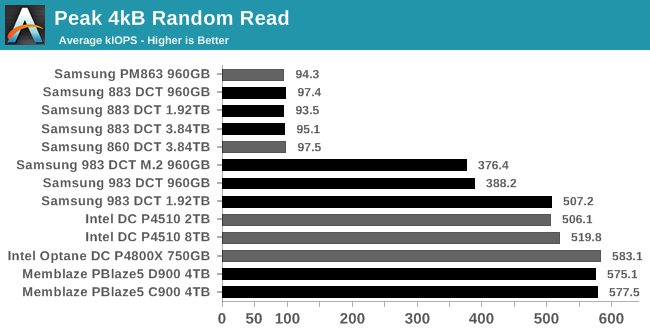
The SATA drives all have no trouble more or less saturating their host interface; they have plenty of flash that could service more read requests if they could actually be delivered to the drive quickly enough. Among NVMe drives, we see some dependence on capacity, with the 960GB Samsung 983 DCT falling well short of the 1.92TB model. The rest of the NVMe drives make it past half a million IOPS before software overhead on the host system becomes a bottleneck, so we don't even get close to seeing the PBlaze5 hit its rated 1M IOPS.
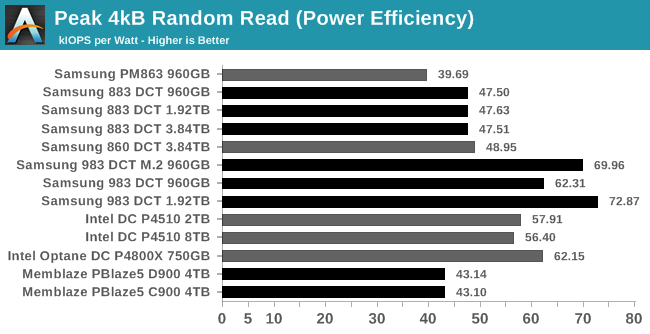 |
|||||||||
| Power Efficiency in kIOPS/W | Average Power in W | ||||||||
The Samsung 983 DCT offers the best power efficiency on this random read test, because the drives with bigger, more power-hungry controllers weren't able to show off their full abilities without hitting bottlenecks elsewhere in the system. The SATA drives offer respectable power efficiency as well, since they are only drawing about 2W to saturate the SATA link.

The 2TB P4510 and both PBlaze5 drives have consistency issues at the 99.99th percentile level, but are fine at the more relaxed 99th percentile threshold. The Optane SSD's latency scores are an order of magnitude better than any of the other NVMe SSDs, and it was the Optane SSD that delivered the highest overall throughput.
Peak Sequential Read Performance
Since this test consists of many threads each performing IO sequentially but without coordination between threads, there's more work for the SSD controller and less opportunity for pre-fetching than there would be with a single thread reading sequentially across the whole drive. The workload as tested bears closer resemblance to a file server streaming to several simultaneous users, rather than resembling a full-disk backup image creation.

The Intel drives don't quite match the performance of the Samsung 983 DCT or the slower PBlaze5. The Optane SSD ends up being the slowest NVMe drive on this test, but it's actually slightly faster than its spec sheet indicates. The Optane SSD's 3D XPoint memory has very low latency, but that doesn't change the fact that the drive's controller only has seven channels to work with. The PBlaze5s are the two fastest drives on this test, but they're both performing significantly below expectations.
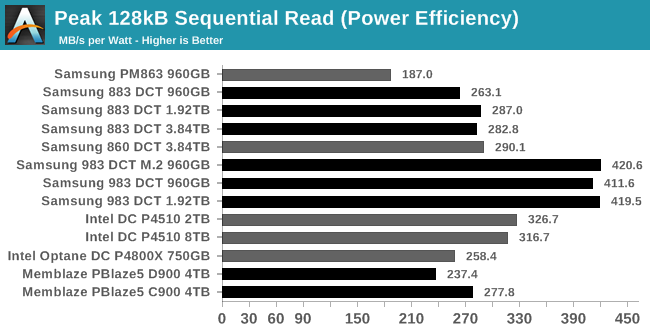 |
|||||||||
| Power Efficiency in MB/s/W | Average Power in W | ||||||||
The Samsung 983 DCT clearly has the lead for power efficiency, followed by the slightly slower and more power-hungry Intel P4510. The current-generation SATA drives from Samsung mostly stay below 2W and end up with decent efficiency scores despite the severe performance bottleneck they have to contend with.
Steady-State Random Write Performance
The hardest task for most enterprise SSDs is to cope with an unending stream of writes. Once all the spare area granted by the high overprovisioning ratios has been used up, the drive has to perform garbage collection while simultaneously continuing to service new write requests, and all while maintaining consistent performance. The next two tests show how the drives hold up after hours of non-stop writes to an already full drive.
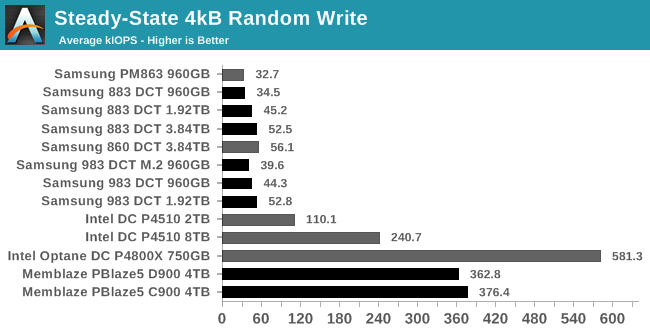
The Samsung drives don't even come close to saturating their host interfaces, but they are performing according to spec for steady-state random writes, with higher-capacity models offering clearly better performance. The Intel and Memblaze drives have a huge advantage, with the slower P4510 maintaining twice the throughput that a 983 DCT can handle.
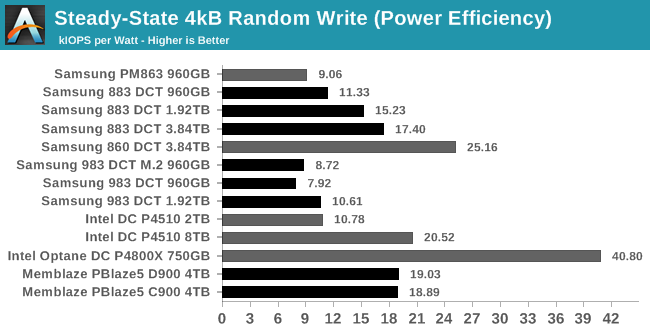 |
|||||||||
| Power Efficiency in kIOPS/W | Average Power in W | ||||||||
The Samsung 983 DCTs used about 1.5W more power to deliver only slightly higher speeds than the Samsung SATA drives, so the NVMe drives wind up with some of the worst power efficiency ratings. The Optane SSD with its wide performance lead more than makes up for its rather high power consumption. In second place for efficiency is the lowly Samsung 860 DCT; despite our best efforts, it continued deliver higher than spec performance results on this test, while drawing less power than the 883 DCT.
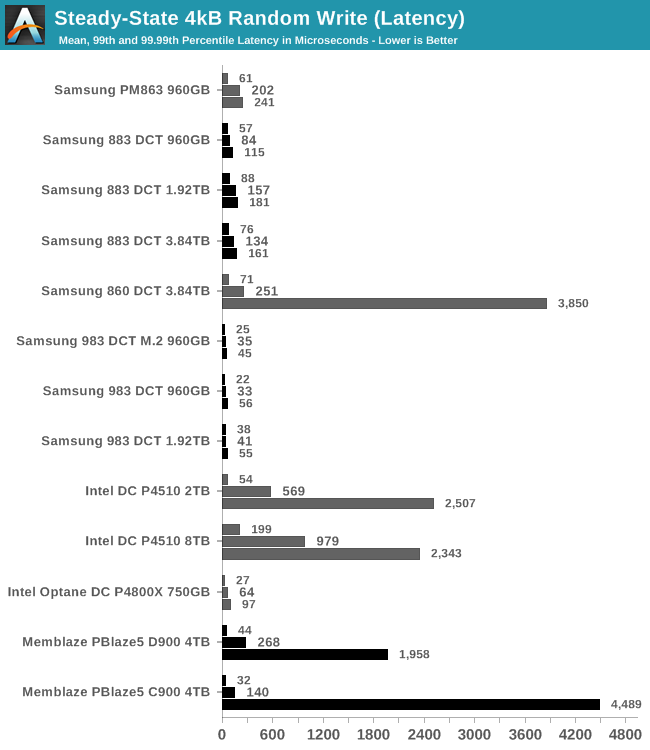
The random write throughput provided by the Samsung 983 DCT at steady-state is nothing special, but it delivers that performance with low latency and extremely good consistency that rivals the Optane SSD. The Intel P4510 and Memblaze PBlaze5 SSDs provide much higher throughput, but with tail latencies that extend into the millisecond range. Samsung's 883 DCT SATA drive also has decent latency behavior that is far better than the 860 DCT.
Steady-State Sequential Write Performance
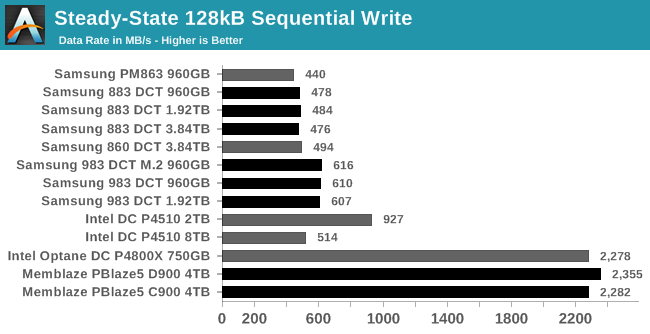
The steady-state sequential write test mostly levels the playing field. Even the NVMe drives rated at or below 1 DWPD offer largely SATA-like write throughput, and only the generously overprovisioned PBlaze5 can keep pace with the Optane SSD.
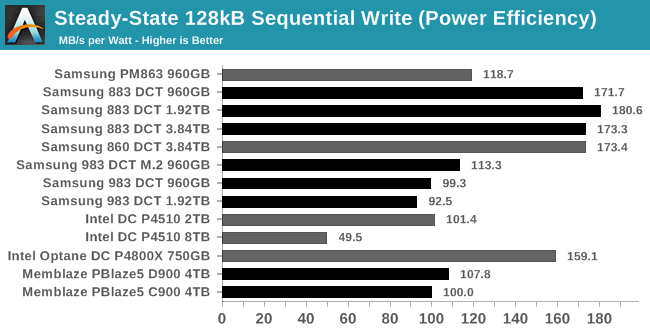 |
|||||||||
| Power Efficiency in MB/s/W | Average Power in W | ||||||||
The PBlaze5 requires over 20W to keep up with what the Optane SSD can deliver at 14W, so despite its high performance the PBlaze5's efficiency is no better than the other NVMe drives. It's the SATA drives that come out well ahead: even though this workload pushes their power consumption relatively high, Samsung's latest generation of SATA drives is still able to keep it under 3W, and that's enough for a clear efficiency win.










36 Comments
View All Comments
Greg100 - Thursday, January 3, 2019 - link
In Europe we have got:Samsung SSD 860 QVO 4TB for € 579 and
Samsung SSD 860 EVO 4TB for € 625
So I think it’s time for something bigger and faster…
Greg100 - Thursday, January 3, 2019 - link
especially, when we have many 15.36TB SAS SSDs from every major manufacturer:Western Digital Ultrastar DC SS530 15.36TB
Seagate Nytro 3330 15.36TB
Toshiba PM5-R 15.36TB
Samsung PM1643 15.36TB
with Samsung PM1643 even double capacity: 30.72TB
...but we can't use SAS SSD on consumer motherboard...
so I count on new U.2 drives.
phoenix_rizzen - Friday, January 4, 2019 - link
Well, you can use SAS drives with consumer-oriented motherboards, you just need to add an SAS HBA via one of the PCIe slots. :) An extra cost, for sure, but it's certainly doable. LSI 92xx-8i or similar aren't that expensive.Greg100 - Saturday, January 5, 2019 - link
Thank you for your advice. You're right, SAS SSDs can be connected to a consumer motherboard, but does it make any sense?SAS SSDs are only given as an example that there are even larger than 8TB SSDs available on the market. It's a pity that they are much more expensive for GB than Intel U.2 drives and much slower. The fastest of the above:
Western Digital Ultrastar DC SS530
15.36TB
2150MB/s (Read)
2120MB/s (Write)
We can get instead:
Intel DC P4510
8TB
3200MB/s (Read)
3000MB/s (Write)
£2,300.78
(Bleepbox on UK ebay; new, in stock)
so....
2x more expensive per GB than Samsung SSD 860 EVO 4TB
6x faster (sequentially) than Samsung SSD 860 EVO 4TB
Is it worth its price?
Is 6x faster CPU worth 2x higher price?
Greg100 - Saturday, January 5, 2019 - link
If someone has to use SAS drives, they pay more for lower performance, but they don't have to rebuild the entire infrastructure.For the consumer who wants:
-big
-fast
-cheap
I think that Intel DC P4510 is the best option
If someone can find
8TB SSD 3000MB/s+ read
cheaper than £2,300.78 let me know...
Billy Tallis - Thursday, January 3, 2019 - link
I don't think we'll see 8TB consumer-oriented drives in 2019, and if we do, they'll make even less sense than Samsung's premature introduction of the 4TB 850 EVO did. Going beyond 8TB will require a new generation of controllers for the consumer market, with support for more DRAM, and that may not be economical until 2TB and 4TB drives are as affordable as 1TB drives are now.Greg100 - Thursday, January 3, 2019 - link
Thank you for your opinion and information on compatibility.So... if I will not see something interesting on CES... I think it is time for Intel DC P4510 8TB (data) and maybe Intel Optane 905P (boot, software)
Greg100 - Thursday, January 3, 2019 - link
One more question:Do you know cause and solution to the issues with the 4TB Samsung drives, you describe here: https://www.anandtech.com/show/13633/the-samsung-8... ?
Billy Tallis - Thursday, January 3, 2019 - link
I haven't been able to pin down the cause or fix. One of the troublesome 4TB 860s did start behaving again, but I'm not sure what part of my messing with it accomplished that and I haven't been able to replicate it with the other two. And the 4TB enterprise Samsung SATA drives (860 DCT and 883 DCT) have been trouble-free but haven't been subjected to the full consumer test suite yet.Greg100 - Thursday, January 3, 2019 - link
Thanks.When you will be able to pin down the cause or fix PLEASE make short article about it or include it with the future 860 DCT and 883 DCT consumer test. I think, it can be very important, especially that they are the biggest client SSDs and with last week significant price drop in Europe they are more affordable.